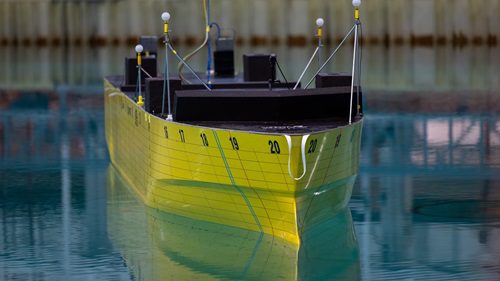 Hurtigruten has revealed its refined vision for Sea Zero—the world’s most energy-efficient and sustainable cruise vessel in a monumental stride for maritime innovation. Backed by a coalition of industry pioneers and the esteemed Norwegian research institute SINTEF, this ambitious project is charting a course toward emission-free operations by 2030, starting with successful model testing at SINTEF Ocean’s world-renowned facilities in Trondheim.
Hurtigruten has revealed its refined vision for Sea Zero—the world’s most energy-efficient and sustainable cruise vessel in a monumental stride for maritime innovation. Backed by a coalition of industry pioneers and the esteemed Norwegian research institute SINTEF, this ambitious project is charting a course toward emission-free operations by 2030, starting with successful model testing at SINTEF Ocean’s world-renowned facilities in Trondheim.
The latest milestone sees the Sea Zero concept advance from digital design to practical experimentation. Utilizing an eight-meter scaled model, researchers at SINTEF’s state-of-the-art ocean basin and towing tank have validated groundbreaking features—like retractable sails and an energy-optimized hull—poised to redefine sustainable cruising.
“We’re learning invaluable lessons with every test,” shared Gerry Larsson-Fedde, Chief Operating Officer of Hurtigruten. “Our early results prove that many of our bold aspirations are not only achievable—they are actionable.”
🚢 A Future-Forward Design with Deep Roots
As custodians of a 130-year legacy navigating Norway’s rugged coastline, Hurtigruten understands the need to evolve without compromising tradition. The new Sea Zero design stretches 143.5 meters in length—making it the largest vessel in the company’s storied fleet—and features two monumental retractable sails lined with solar panels. Based on recent physical and numerical simulations, these alone are estimated to slash energy usage by 10–15%.
The ship’s updated profile is lower by one deck, offering better stability, and wider to accommodate larger battery packs. By transitioning from three sails to two, Hurtigruten has balanced efficiency and aesthetics—an homage to Scandinavian maritime heritage with a keen eye on future climate resilience.
“Each testing cycle brings refinements,” added Larsson-Fedde. “The longer and slightly broader design enhances stability while optimizing energy use, which is vital to meeting our zero-emissions target.”

The model of the Sea Zero ship in the Sea Basin at Tyholt in Trondheim. Photo: Espen Mills / Hurtigruten
⚡ Breakthroughs in Green Maritime Engineering
At the heart of Sea Zero is an array of forward-thinking technologies working in harmony: contra-rotating propellers for propulsion efficiency, air lubrication systems to reduce drag, and intelligent onboard energy systems managing everything from heating to cooling.
Trond Johnsen, Project Manager for Sea Zero, emphasized the game-changing potential of energy reductions:
“If we can consistently reduce energy demand by up to 50%, battery systems powered by shore-based electricity will be sufficient to enable clean voyages along the Norwegian coast—even in typical weather conditions.”
That’s not just wishful thinking—it’s grounded in meticulous engineering and cutting-edge testing protocols.
🔬 The Power of Partnership
Hurtigruten has joined forces with some of the maritime industry’s most respected institutions, including Vard Design, DNV, Brunvoll, Plug, Corvus Energy, and SINTEF. Together, they are redefining what’s possible in marine innovation.
Anders Alterskjær, SINTEF Ocean’s Research Manager, underlined the importance of collaboration:
“We’ve developed new lab instruments and advanced simulations to understand the dynamic interplay of these technologies. The results so far are not just promising—they are transformative.”
🌿 A Vision Anchored in Legacy and Necessity
For Hurtigruten, Sea Zero is more than a vessel—it is a statement of purpose. Hedda Felin, CEO of Hurtigruten, spoke to the company’s generational commitment:
“The Coastal Express has sailed the Norwegian coast for over 130 years. To ensure we sail for another 130, we must reinvent how we navigate these waters.”
That reinvention isn’t a luxury; it’s an imperative in an era of climate urgency.

Hurtigruten shares updated designs that have been updated following recent months of research and development. Illustration: Vard Design / Hurtigruten
🔍 Fast Facts: Sea Zero
-
Target: World’s most energy-efficient cruise ship
-
Emission-Free Operation: Planned for 2030
-
Length: 143.5 meters (longest in Hurtigruten’s fleet)
-
Energy Reduction Goal: 40–50% vs current fleet
-
Key Innovations: Two retractable solar sails, energy-optimized hull, intelligent onboard systems, contra-rotating propellers, air lubrication
-
Consortium Partners: SINTEF, Vard Design, DNV, Plug, Brunvoll, Corvus Energy
📈 Leading by Example
As other cruise lines grapple with carbon-reduction roadmaps, Hurtigruten is actively engineering the blueprint for net-zero maritime travel. Sea Zero doesn’t just promise cleaner cruising—it embodies it through measurable, tested innovation. The ship is a beacon of environmental stewardship in an industry often under scrutiny.
Through this bold initiative, Hurtigruten reaffirms its commitment to sustainability, Scandinavian ingenuity, and a future where tourism and environmental responsibility coexist.
For more information, visit www.hurtigruten.com.
Written by: Christine Nguyen




















